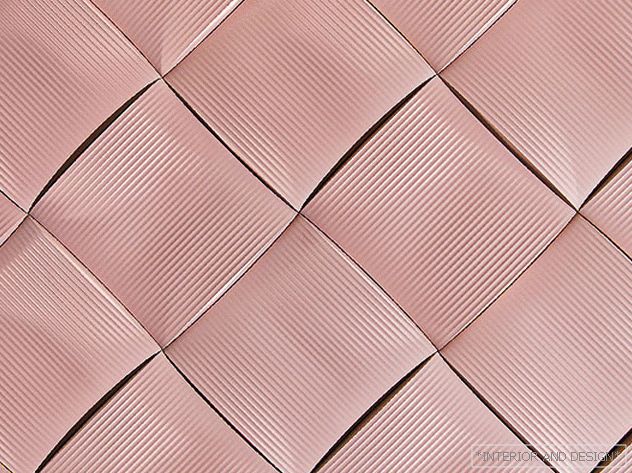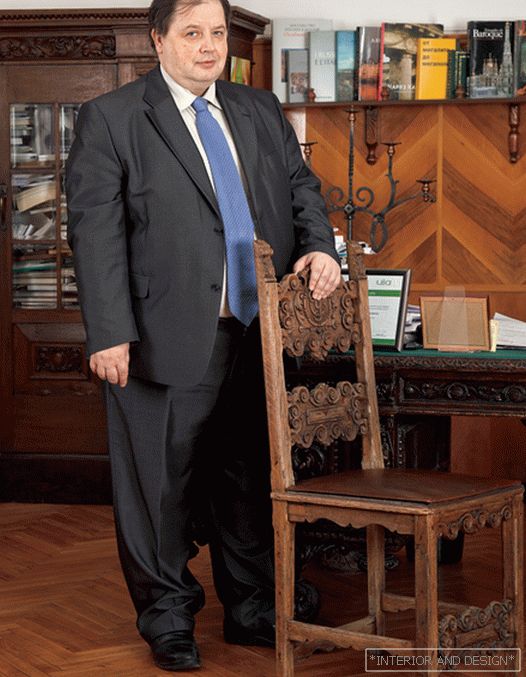Designer Chris Coleman (Chris Coleman) designed the apartment in Manhattan in the fashionable Upper West Side. This author, based in New York, is famous for his unbanal approach to design and even earned the nickname Showman. “It’s always nice when something is fraught with surprise,” explained Coleman in an exclusive interview with INTERIOR + DESIGN magazine. - You look - it seems like a house is like a house, and you do not even suppose that there could be such a thing inside! The individuality of the owner, as well as the guest designer, is what defines the image of the interior. And not a facade or a quarter.
 The author of the project, designer Chris Coleman at the Poggenpohl kitchen, which his customers dreamed of.
The author of the project, designer Chris Coleman at the Poggenpohl kitchen, which his customers dreamed of. In this case, my customers became a young couple with two children, natives of Venezuela. The apartments they bought were luxurious, but too standard. It seemed to me that fresh, bright colors would suit these people much more. A noteworthy detail: the customers made it a prerequisite to purchase the Poggenpohl kitchen and Miele home appliances: they love to cook in this family and trust only German brands in the kitchen area. Spaces in the house are created flexible, open, flow one into another. I chose materials that support this overflow.
“Luxury in relation to the interior is not a palace hall or a suite of a five-star hotel. Luxury is style. As well as the craft quality that is felt at the first glance. "
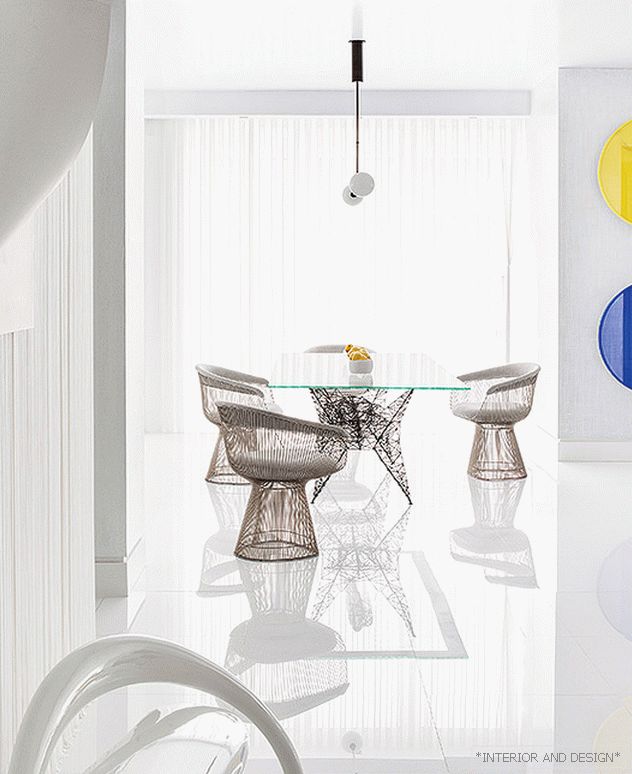 The floor is lined with white quartz, polished to a mirror finish. 1960s W. Platner chairs and T. Dixon's table - these items are joined by a metal base. Blue and yellow discs - the work of an unknown artist.
The floor is lined with white quartz, polished to a mirror finish. 1960s W. Platner chairs and T. Dixon's table - these items are joined by a metal base. Blue and yellow discs - the work of an unknown artist.  In the hall on the wall is the work of K. Medina.
In the hall on the wall is the work of K. Medina. 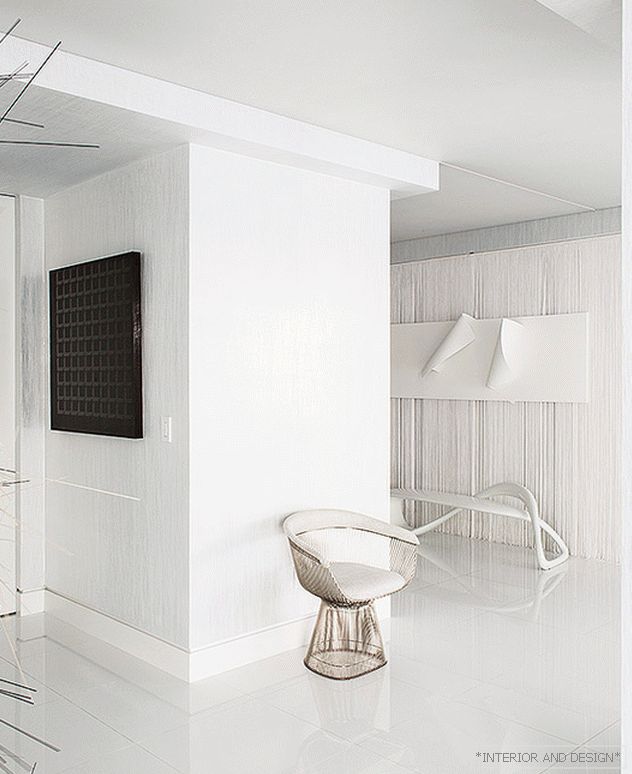 Armchair of W. Platner, a picture by M. Minignelli.
Armchair of W. Platner, a picture by M. Minignelli.  The angular location of the apartment gives a gain in natural light. Vintage chairs purchased in New York. In the foreground to the right is a metal table, diz. T. Schreiber.
The angular location of the apartment gives a gain in natural light. Vintage chairs purchased in New York. In the foreground to the right is a metal table, diz. T. Schreiber. 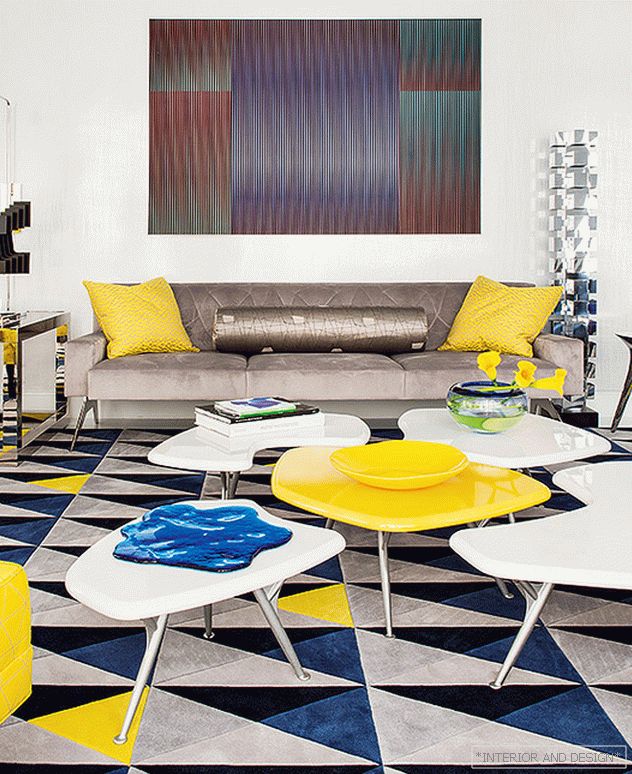 Living room: author of the work on the wall - C. Cruz Diaz. Sofa Khouri Guzman Bunce Lininger. Floor Lamp C. Gere (1971). Chrome steel. Yellow bowl: Sentou Paris.
Living room: author of the work on the wall - C. Cruz Diaz. Sofa Khouri Guzman Bunce Lininger. Floor Lamp C. Gere (1971). Chrome steel. Yellow bowl: Sentou Paris. 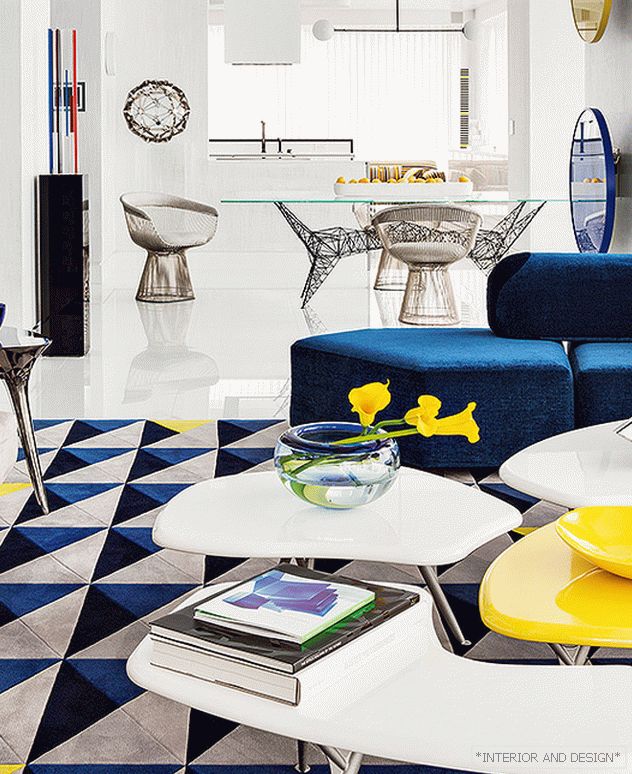 Coffee tables DDC. Chandelier-mobile, diz. M. Anastasiades. As in all Coleman projects, Joe Ponty’s influence is felt here: the “edges” of the carpet (implementation: Tai Ping) refer to the work of the great Italian.
Coffee tables DDC. Chandelier-mobile, diz. M. Anastasiades. As in all Coleman projects, Joe Ponty’s influence is felt here: the “edges” of the carpet (implementation: Tai Ping) refer to the work of the great Italian. 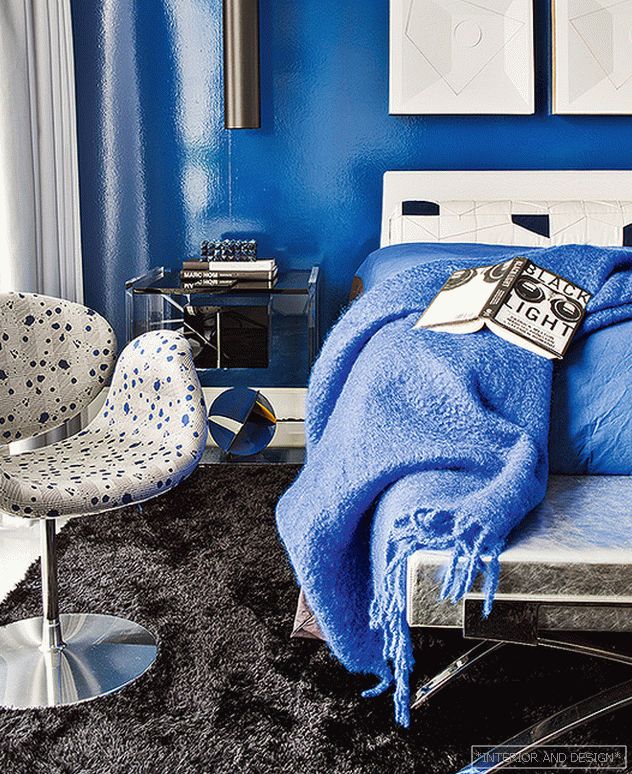 Bedroom. Chair, diz. P. Polen, Artifort. Banquette Holly Hunt, lamp Artemide.
Bedroom. Chair, diz. P. Polen, Artifort. Banquette Holly Hunt, lamp Artemide.  The bedroom is the bluest room in the house. The author of the white works on the wall: K. Yoshida. Curbstone Carriage House. In the role of a bedside lamp pendant lamp Artemide.
The bedroom is the bluest room in the house. The author of the white works on the wall: K. Yoshida. Curbstone Carriage House. In the role of a bedside lamp pendant lamp Artemide. 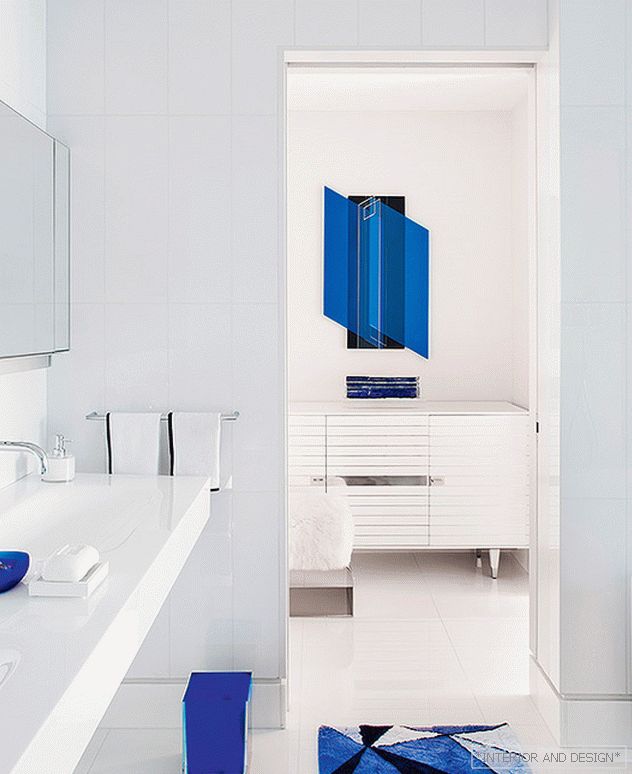 The author of the blue work on the wall: O. Herrera. On the dresser from the Bright Group sculpture: lapis lazuli in the case of Lucite. Near "fur" stool, diz. A. Shladovski.
The author of the blue work on the wall: O. Herrera. On the dresser from the Bright Group sculpture: lapis lazuli in the case of Lucite. Near "fur" stool, diz. A. Shladovski. 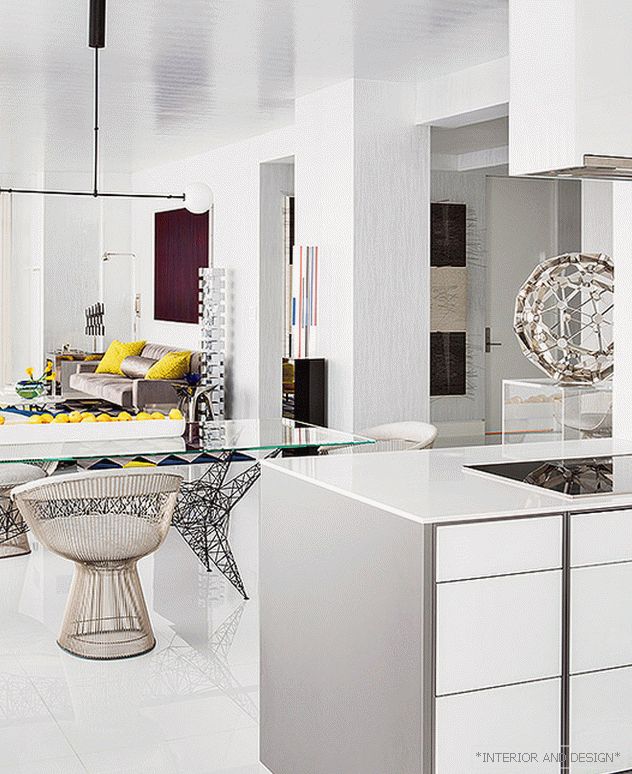 The Poggenpohl kitchen is integrated into the living room.
The Poggenpohl kitchen is integrated into the living room. 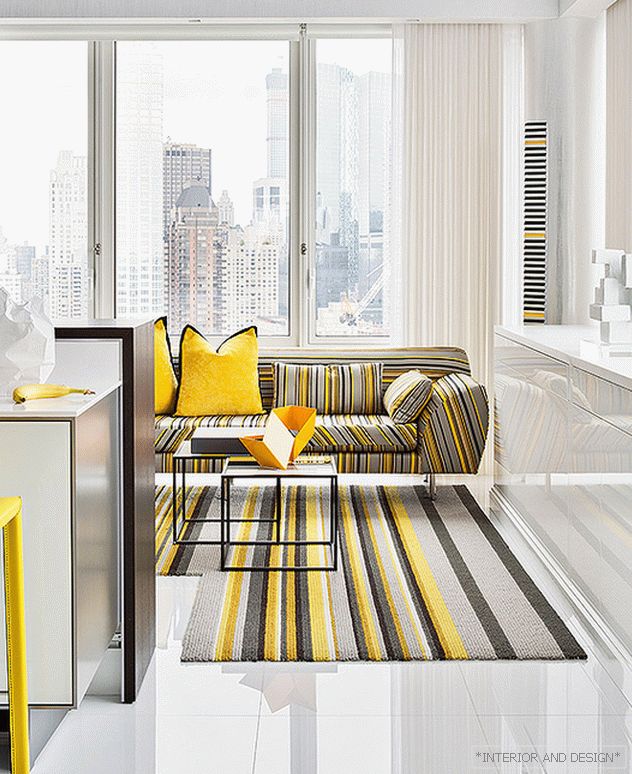 Sofa Breuton, yellow sculpture: K. Evangelista.
Sofa Breuton, yellow sculpture: K. Evangelista. 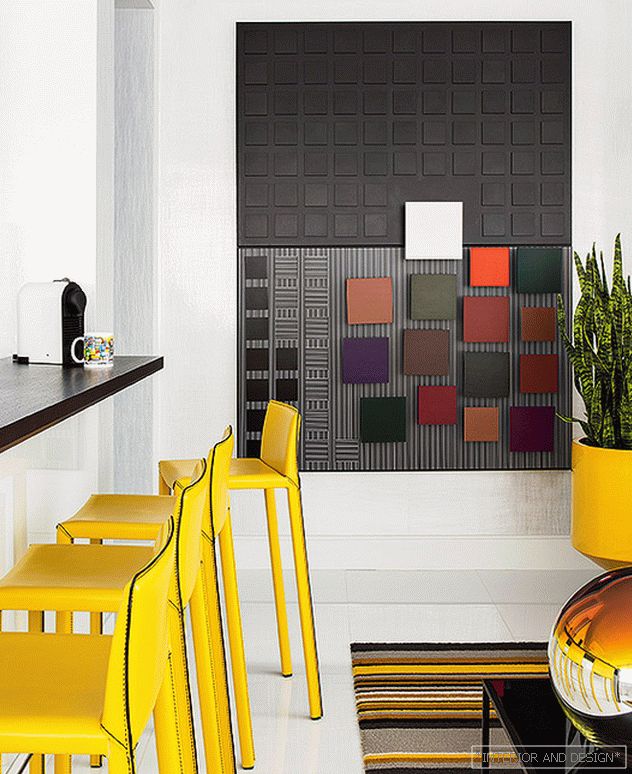 On the wall is the work of Venezuelan author H.-R. Soto, one of the leading figures of op-art. Bar Stools in DDC Leather. Sculpture-ball H. Harris. Tai Ping Rug.
On the wall is the work of Venezuelan author H.-R. Soto, one of the leading figures of op-art. Bar Stools in DDC Leather. Sculpture-ball H. Harris. Tai Ping Rug. “Often pay attention to the combinations of shades offered by reputable interior publications and top designers, fix them in mindboards and albums.
On the floor slabs of white quartz (by the way, this is my favorite finish). They are also on the ceiling, making the apartment seem larger and more spacious. For a very long time, for several months, I searched for furniture and accessories: I brought them from Paris, Antwerp, Miami, of course, I found a lot in New York. The design of the 1960s fits in well with the desired palette. Customers have a serious collection of contemporary art, mainly Latin American authors. Already at the planning stage, we, together with the client, defined a place for each work, thought out how the works would interact with each other - I confess, it was a painful process. In general, for an average person, I advise you to treat art very carefully, academically. Or, on the contrary, to group the provocative ensemble, pushing different pictures in color, technique and style. The worst of the options is when only one tiny picture can be seen on the wall. ”
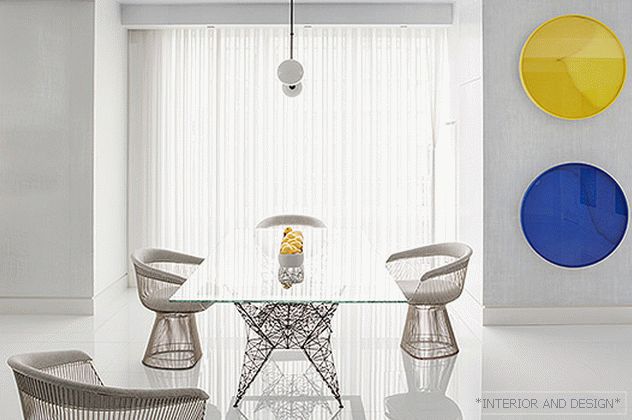 "Already at the stage of working on the layout, we, together with the client, determined the place for each work of art."
"Already at the stage of working on the layout, we, together with the client, determined the place for each work of art." “Luxury in relation to the interior is not a palace hall or a suite of a five-star hotel,” the designer voiced his philosophy to us. - Luxury is style. As well as handicraft quality, which is felt at first glance. What I advise to avoid is stamps and roll towards some component: for example, when everything is only in a tree, or in a beige color, or many things in the same style from the same manufacturer. It is also very important to respect the space that you decorate. Although this does not mean that it is forbidden to create a modern interior in a historic building. ”
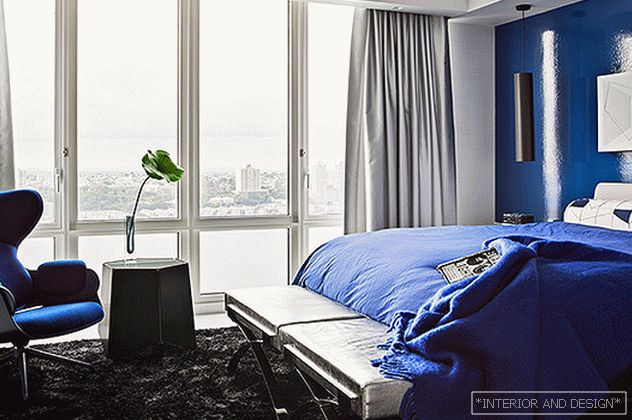 One of Chris Coleman's favorites is blue. The designer boldly uses blue shades in the bedroom. Left: Showtime design chair Jaime Iona for BD Barselona.
One of Chris Coleman's favorites is blue. The designer boldly uses blue shades in the bedroom. Left: Showtime design chair Jaime Iona for BD Barselona. Chris Coleman is known as a talented colorist. Here is his advice: “Often pay attention to the combinations of shades that authoritative interior publications and top-end designers offer, fix them in the mindboards and albums. Do not trust samples of paints on paper that you see in stores, be sure to do a test paint on a piece of cardboard, and even better on the wall. It may be small, say 10 x 10 cm. See how the paint looks in different lighting, invite all family members, discuss your impressions. It’s very important that you really like the color. ”
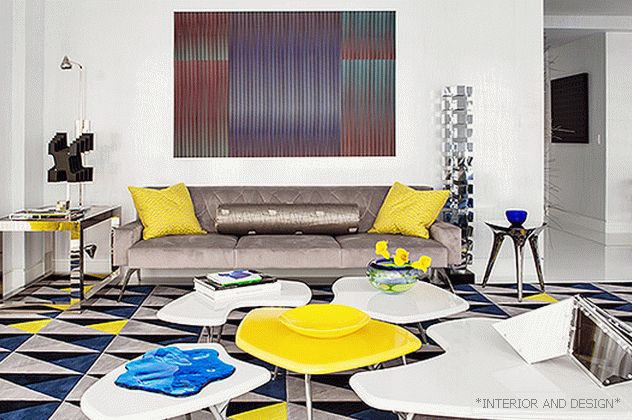 Coleman is looking for things in the spirit of Ponty around the world. And if he does not find it, he designs it himself. In this case, the carpet in the living room became such an object.
Coleman is looking for things in the spirit of Ponty around the world. And if he does not find it, he designs it himself. In this case, the carpet in the living room became such an object. “Whatever project I do, it influences Joe Ponty’s influence in one way or another,” Chris Coleman confessed to us. “He’s my teacher and design guru.” Joe Ponty (1891–1979) was a great Italian artist, architect, designer, publisher, essayist. At one time, Coleman even specifically went to Caracas, where he carefully examined the Butterfly Villa soaring above the city, one of the most successful works of the master; It was built in 1956. A unique monument, where everything, from the walls to the plates, was made by one author.
Related: Joe Ponti (Gio Ponti): 125th Birthday of Maestro
Ponty was a fan of man-made, appreciated the craft. He imposed the tone on the tone and ornament on the ornament, leaving almost no surface without decor. On the floor, he created a kilt of multi-colored marble slabs, the ceilings were lined with diagonal stripes, and covered the tables with a geometric color pattern. Ponti loved diamond edges, applied the diamond motif both in decoration, and in furniture, and even in architecture - you should look at his 32-storey Pirelli tower in Milan.
By topic: Furniture hits 2016: 3D
Coleman is looking for things in the spirit of Ponty around the world. And if he does not find it, he designs it himself. In this case, the carpet in the living room became such an object.
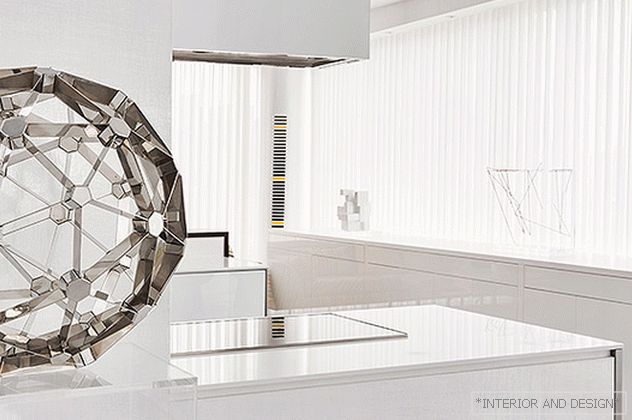 “Customers put the purchase of Poggenpohl kitchen appliances and Miele household appliances as a prerequisite: they love to cook in this family and trust only German brands on the kitchen area.
“Customers put the purchase of Poggenpohl kitchen appliances and Miele household appliances as a prerequisite: they love to cook in this family and trust only German brands on the kitchen area. 
